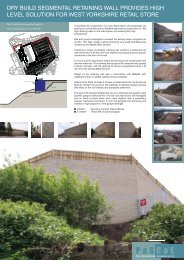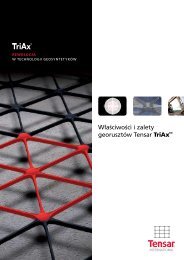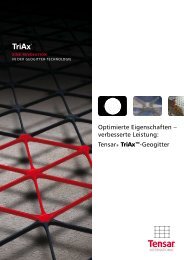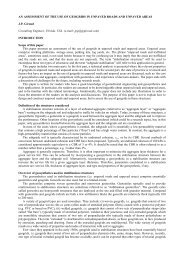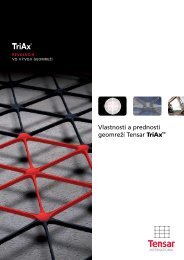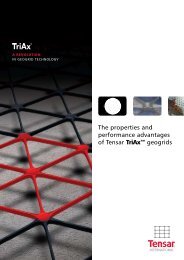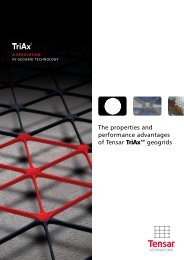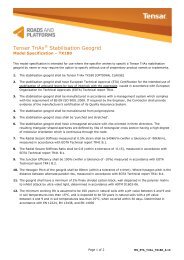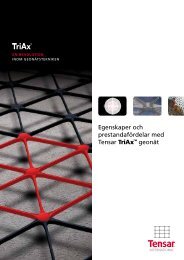Research on the behaviour of geogrids in stabilisation applications ...
Research on the behaviour of geogrids in stabilisation applications ...
Research on the behaviour of geogrids in stabilisation applications ...
You also want an ePaper? Increase the reach of your titles
YUMPU automatically turns print PDFs into web optimized ePapers that Google loves.
RESEARCH ON THE BEHAVIOUR OF GEOGRIDS IN STABILISATION APPLICATIONS<br />
Erol Tutumluer 1 , Hai Huang 2 & Xuecheng Bian 3<br />
Civil & Envir<strong>on</strong>mental Eng<strong>in</strong>eer<strong>in</strong>g, University <strong>of</strong> Ill<strong>in</strong>ois, Urbana, IL 61801, USA.<br />
1<br />
(e-mail: tutumlue@ill<strong>in</strong>ois.edu)<br />
2<br />
(e-mail: hhuang14@ill<strong>in</strong>ois.edu)<br />
3<br />
(e-mail: bianxc@ill<strong>in</strong>ois.edu)<br />
INTRODUCTION<br />
Geogrids are <strong>the</strong> most popular type <strong>of</strong> geosyn<strong>the</strong>tics used <strong>in</strong> <strong>the</strong> road c<strong>on</strong>structi<strong>on</strong> <strong>in</strong>dustry for mechanical<br />
stabilisati<strong>on</strong> and re<strong>in</strong>forcement purposes. Geogrids are comm<strong>on</strong>ly used over weak subgrade soils to provide a work<strong>in</strong>g<br />
platform for c<strong>on</strong>structi<strong>on</strong> equipment. Often referred to as “subgrade restra<strong>in</strong>t” design, such an applicati<strong>on</strong> places a<br />
geogrid at <strong>the</strong> subgrade/aggregate cover <strong>in</strong>terface to <strong>in</strong>crease <strong>the</strong> bear<strong>in</strong>g capacity or <strong>the</strong> support <strong>of</strong> c<strong>on</strong>structi<strong>on</strong><br />
equipment over a s<strong>of</strong>t subgrade. S<strong>in</strong>ce <strong>the</strong> aggregate cover opti<strong>on</strong> requires large thicknesses for low subgrade<br />
strengths, <strong>the</strong> subgrade restra<strong>in</strong>t use <strong>of</strong> geogrid re<strong>in</strong>forcement can <strong>the</strong>refore be quite beneficial by <strong>of</strong>fer<strong>in</strong>g a reduced<br />
aggregate thickness alternative.<br />
Geogrids can perform as tensile re<strong>in</strong>forcement for aggregate base courses <strong>in</strong> flexible or asphalt pavements. Add<strong>in</strong>g<br />
a geogrid layer can mechanically stabilise aggregate particles and <strong>in</strong>crease bear<strong>in</strong>g capacity <strong>of</strong> a pavement structure by<br />
forc<strong>in</strong>g <strong>the</strong> potential bear<strong>in</strong>g capacity surface to develop al<strong>on</strong>g alternate, higher shear strength surfaces. The lateral<br />
restra<strong>in</strong>t and/or membrane tensi<strong>on</strong> effects may also c<strong>on</strong>tribute to load carry<strong>in</strong>g capacity as <strong>the</strong> wheel loads attempt to<br />
cause rutt<strong>in</strong>g <strong>in</strong> <strong>the</strong> pavement foundati<strong>on</strong> layers, i.e., unbound aggregate base/subbase and subgrade soil.<br />
Through <strong>the</strong> <strong>in</strong>terlock between <strong>the</strong> <strong>geogrids</strong> and aggregate, <strong>geogrids</strong> are assumed to have higher fricti<strong>on</strong> and<br />
c<strong>on</strong>f<strong>in</strong><strong>in</strong>g stresses than <strong>the</strong> smoo<strong>the</strong>r surfaced geotextiles. This is <strong>in</strong> part due to <strong>the</strong> additi<strong>on</strong>al bear<strong>in</strong>g stresses created<br />
<strong>in</strong> <strong>the</strong> geogrid apertures as soil and aggregate particles provide <strong>the</strong> <strong>in</strong>terlock <strong>in</strong> <strong>the</strong>se open<strong>in</strong>gs. When placed <strong>in</strong> a<br />
granular base course, <strong>geogrids</strong> may restra<strong>in</strong> <strong>the</strong> lateral spread<strong>in</strong>g <strong>of</strong> <strong>the</strong> granular base layer, and through <strong>in</strong>terlock<strong>in</strong>g,<br />
may develop a relatively “stiffer” layer surround<strong>in</strong>g <strong>the</strong> geogrid. Granular “base re<strong>in</strong>forcement” <strong>of</strong> <strong>geogrids</strong> could be<br />
crucial to ensur<strong>in</strong>g <strong>the</strong>ir successful and beneficial applicati<strong>on</strong> <strong>in</strong> low to moderate volume roads hav<strong>in</strong>g th<strong>in</strong> hot-mix<br />
asphalt (HMA) surfaces and subgrade California Bear<strong>in</strong>g Ratios (CBRs) between 3 to 8 percent. In additi<strong>on</strong> to<br />
potentially reduc<strong>in</strong>g shear deformati<strong>on</strong> <strong>in</strong> aggregates, <strong>the</strong> c<strong>on</strong>trol <strong>of</strong> aggregate movement, especially <strong>in</strong> <strong>the</strong> upper part<br />
<strong>of</strong> <strong>the</strong> layer adjacent to <strong>the</strong> HMA, may also reduce HMA fatigue. Hence, a geogrid <strong>in</strong>terlayer system can typically be<br />
used to reduce <strong>the</strong> overall thickness <strong>of</strong> a pavement system for a target design life or extend <strong>the</strong> design life <strong>of</strong> <strong>the</strong><br />
pavement.<br />
This paper highlights subgrade restra<strong>in</strong>t and base re<strong>in</strong>forcement applicati<strong>on</strong>s <strong>of</strong> <strong>geogrids</strong> <strong>in</strong> road <strong>in</strong>frastructure. The<br />
paper also describes recent research efforts <strong>in</strong> numerical model<strong>in</strong>g and field studies which helped identify and quantify<br />
<strong>the</strong> geogrid re<strong>in</strong>forcement mechanism <strong>in</strong> unbound aggregate layers <strong>of</strong> pavement systems. The primary geogrid<br />
re<strong>in</strong>forcement mechanism <strong>of</strong> improved aggregate <strong>in</strong>terlock and its importance <strong>in</strong> prevent<strong>in</strong>g aggregate lateral<br />
movements is dem<strong>on</strong>strated <strong>in</strong> this paper by <strong>the</strong> use <strong>of</strong> an <strong>in</strong>novative image-aided Discrete Element Model<strong>in</strong>g (DEM)<br />
approach for different rectangular and triangular <strong>geogrids</strong> <strong>in</strong> a shear box DEM model. F<strong>in</strong>ally, a recent field validated<br />
mechanistic model developed at <strong>the</strong> University <strong>of</strong> Ill<strong>in</strong>ois for geogrid base re<strong>in</strong>forced flexible pavements is given as an<br />
example to dem<strong>on</strong>strate how <strong>the</strong> c<strong>on</strong>cept <strong>of</strong> compacti<strong>on</strong> <strong>in</strong>duced residual stresses can be <strong>in</strong>cluded <strong>in</strong> f<strong>in</strong>ite element<br />
analysis as an <strong>in</strong>itial c<strong>on</strong>diti<strong>on</strong> and how such an approach can effectively represent <strong>the</strong> c<strong>on</strong>tributi<strong>on</strong> <strong>of</strong> geogrid<br />
re<strong>in</strong>forcement <strong>in</strong> <strong>the</strong> form <strong>of</strong> stiffened z<strong>on</strong>e <strong>in</strong> mechanistic pavement analysis.<br />
SUBGRADE RESTRAINT SOLUTIONS<br />
Several design soluti<strong>on</strong>s based <strong>on</strong> <strong>the</strong> bear<strong>in</strong>g capacity for soil strength have been developed to evaluate aggregate<br />
thickness for subgrade restra<strong>in</strong>t with geosyn<strong>the</strong>tics. However, <strong>on</strong>ly a few recent design approaches by T<strong>in</strong>gle &<br />
Webster (2003) and Giroud & Han (2004) take <strong>in</strong>to account improved re<strong>in</strong>forcement benefits provided by <strong>geogrids</strong><br />
over geotextiles by <strong>in</strong>creas<strong>in</strong>g <strong>the</strong> bear<strong>in</strong>g capacity factor N c <strong>in</strong> <strong>the</strong> equati<strong>on</strong> and, <strong>in</strong> <strong>the</strong> case <strong>of</strong> <strong>the</strong> Giroud & Han<br />
(2004) approach, <strong>in</strong>clud<strong>in</strong>g a c<strong>on</strong>siderati<strong>on</strong> for aperture stability modulus <strong>in</strong> <strong>the</strong> soluti<strong>on</strong>. In additi<strong>on</strong>, a geosyn<strong>the</strong>tics<br />
design procedure was also developed for th<strong>in</strong> asphalt roads <strong>on</strong> s<strong>of</strong>t subgrade soils by <strong>the</strong> Dutch agency CROW (van<br />
Gurp & van Leest 2002). Accord<strong>in</strong>g to <strong>the</strong>ir approach, <strong>the</strong> amount <strong>of</strong> thickness reducti<strong>on</strong> <strong>of</strong>ten depends <strong>on</strong> <strong>the</strong> type<br />
and strength/stiffness characteristics <strong>of</strong> <strong>the</strong> geosyn<strong>the</strong>tics, aggregate, and <strong>the</strong> subgrade soil comb<strong>in</strong>ati<strong>on</strong> with <strong>geogrids</strong><br />
provid<strong>in</strong>g better re<strong>in</strong>forcement benefits over geotextiles.<br />
Based <strong>on</strong> recent research at <strong>the</strong> University <strong>of</strong> Ill<strong>in</strong>ois, aggregate cover thicknesses were found to depend <strong>on</strong> <strong>the</strong><br />
type and strength/stiffness characteristics <strong>of</strong> <strong>the</strong> geosyn<strong>the</strong>tic, aggregate, and <strong>the</strong> subgrade soil strength, Tutumluer &<br />
Kw<strong>on</strong> (2006). Much higher base course reducti<strong>on</strong>s from <strong>the</strong> unre<strong>in</strong>forced cases and <strong>the</strong>refore benefits were observed<br />
when us<strong>in</strong>g <strong>geogrids</strong> <strong>in</strong>stead <strong>of</strong> geotextiles. The f<strong>in</strong>d<strong>in</strong>gs were compiled to establish thickness reducti<strong>on</strong> guidel<strong>in</strong>es for<br />
Ill<strong>in</strong>ois Department <strong>of</strong> Transportati<strong>on</strong> (IDOT) <strong>in</strong> <strong>the</strong>ir Subgrade Stability Manual, IDOT (2005).<br />
Note that not all types and/or brands <strong>of</strong> <strong>geogrids</strong> have <strong>the</strong> same eng<strong>in</strong>eer<strong>in</strong>g properties, which makes <strong>the</strong><br />
performance and, c<strong>on</strong>sequently, <strong>the</strong> specificati<strong>on</strong>s <strong>of</strong> <strong>geogrids</strong> product specific. For this reas<strong>on</strong> many transportati<strong>on</strong><br />
agencies do not have generic specificati<strong>on</strong>s that could be applied to all geogrid products used for subgrade restra<strong>in</strong>t.
Fur<strong>the</strong>r, both <strong>the</strong> Ill<strong>in</strong>ois DOT guidel<strong>in</strong>es and CROW methodologies <strong>on</strong>ly allow a maximum reducti<strong>on</strong> <strong>of</strong> 150 mm<br />
from <strong>the</strong> unre<strong>in</strong>forced thickness for a more c<strong>on</strong>servative use <strong>of</strong> <strong>geogrids</strong> <strong>in</strong> <strong>the</strong> subgrade restra<strong>in</strong>t applicati<strong>on</strong>. All <strong>the</strong>se<br />
limitati<strong>on</strong>s stem from a lack <strong>of</strong> understand<strong>in</strong>g <strong>of</strong> <strong>the</strong> ma<strong>in</strong> mechanism by which <strong>geogrids</strong> re<strong>in</strong>force and how this<br />
mechanism needs to be <strong>in</strong>corporated <strong>in</strong>to a mechanistic based analysis procedure.<br />
REINFORCEMENT MECHANISM THROUGH AGGREGATE INTERLOCK<br />
The mechanical <strong>in</strong>terlock is vital for <strong>the</strong> performance <strong>of</strong> any geogrid <strong>in</strong> mechanical stabilisati<strong>on</strong> and pavement<br />
re<strong>in</strong>forcement. It is a typical property <strong>of</strong> <strong>geogrids</strong>, occurr<strong>in</strong>g when well graded granular fill is compacted <strong>on</strong> top <strong>of</strong> a<br />
geogrid, lett<strong>in</strong>g <strong>the</strong> coarser particles partially project through <strong>the</strong> geogrid’s apertures to lock <strong>the</strong>m <strong>in</strong>to place. The<br />
mechanical <strong>in</strong>terlock and <strong>the</strong> result<strong>in</strong>g lateral restra<strong>in</strong>t <strong>of</strong> <strong>the</strong> granular layer assembly expla<strong>in</strong>s <strong>the</strong> performance<br />
provided by extruded <strong>geogrids</strong> compared to geotextiles and o<strong>the</strong>r <strong>geogrids</strong>, even with comparable values <strong>of</strong> some<br />
<strong>in</strong>dex properties such as modulus or ultimate tensile strength as dem<strong>on</strong>strated by a US Army Corp <strong>of</strong> Eng<strong>in</strong>eers study,<br />
Webster (1992) and o<strong>the</strong>r research by Berg et al. (2000).<br />
On <strong>the</strong> <strong>in</strong>terlock between <strong>the</strong> geogrid and aggregate particles, <strong>the</strong> study by Jewell et al. (1984) identified early <strong>on</strong><br />
<strong>the</strong> important mechanisms <strong>of</strong> soil and geogrid <strong>in</strong>teracti<strong>on</strong>s through <strong>the</strong> use <strong>of</strong> large shear box test<strong>in</strong>g. Seven granular<br />
soils re<strong>in</strong>forced with a biaxial geogrid with an aperture width 17.3 mm were tested. The peak direct shear forces and<br />
<strong>the</strong> slid<strong>in</strong>g resistances measured for <strong>the</strong> various soil gradati<strong>on</strong>s adopted <strong>in</strong>dicated that <strong>the</strong> relative size <strong>of</strong> <strong>the</strong> aggregate<br />
particle and its gradati<strong>on</strong> compared to <strong>the</strong> grid aperture had an <strong>in</strong>fluence <strong>on</strong> <strong>the</strong> size <strong>of</strong> <strong>the</strong> rupture z<strong>on</strong>e. The research<br />
f<strong>in</strong>d<strong>in</strong>gs <strong>of</strong> Jewell et al. (1984) <strong>the</strong>refore laid down <strong>the</strong> foundati<strong>on</strong> for understand<strong>in</strong>g <strong>the</strong> fundamental mechanisms by<br />
which <strong>geogrids</strong> re<strong>in</strong>force pavement systems by enterta<strong>in</strong><strong>in</strong>g <strong>the</strong> idea <strong>of</strong> choos<strong>in</strong>g <strong>the</strong> type <strong>of</strong> geogrid for <strong>the</strong> <strong>in</strong>tended<br />
aggregate particle sizes and gradati<strong>on</strong>.<br />
Discrete element model<strong>in</strong>g (DEM) studies<br />
The Discrete Element Method is <strong>on</strong>e <strong>of</strong> <strong>the</strong> most realistic model<strong>in</strong>g techniques for simulat<strong>in</strong>g complex<br />
soil/aggregate geogrid <strong>in</strong>teracti<strong>on</strong>. This micro scale numerical simulati<strong>on</strong> approach is fully capable <strong>of</strong> model<strong>in</strong>g <strong>the</strong><br />
most realistic <strong>in</strong>teracti<strong>on</strong> <strong>of</strong> soil/aggregate particles and <strong>the</strong> geogrid by reproduc<strong>in</strong>g <strong>the</strong> actual geometry, assign<strong>in</strong>g<br />
properly <strong>geogrids</strong> and soil properties and account<strong>in</strong>g for <strong>the</strong> aggregate particle size distributi<strong>on</strong> and shape. In this<br />
methodology, multiple <strong>in</strong>teract<strong>in</strong>g bodies undergo<strong>in</strong>g large dynamic moti<strong>on</strong>s can be modeled by model<strong>in</strong>g <strong>the</strong><br />
<strong>in</strong>dividual particles or elements and comput<strong>in</strong>g <strong>the</strong>ir moti<strong>on</strong>, and <strong>the</strong> overall behavior <strong>of</strong> <strong>the</strong> assembly. Force<br />
displacement laws for different element b<strong>on</strong>d<strong>in</strong>g c<strong>on</strong>diti<strong>on</strong>s and <strong>the</strong> law <strong>of</strong> moti<strong>on</strong> govern <strong>the</strong> movement and c<strong>on</strong>tacts<br />
<strong>of</strong> each element with<strong>in</strong> <strong>the</strong> assembly <strong>of</strong> elements.<br />
Recent work by <strong>the</strong> ITASCA Group <strong>in</strong> Germany and <strong>the</strong> University <strong>of</strong> Nott<strong>in</strong>gham <strong>in</strong> <strong>the</strong> UK focused <strong>on</strong><br />
<strong>in</strong>vestigat<strong>in</strong>g aggregate and geogrid <strong>in</strong>teracti<strong>on</strong>s and model<strong>in</strong>g c<strong>on</strong>f<strong>in</strong>ement effects us<strong>in</strong>g three-dimensi<strong>on</strong>al Particle<br />
Flow Code (PFC3D) DEM program, K<strong>on</strong>ietzky et al. (2004) and McDowell et al. (2006) utiliz<strong>in</strong>g spherical discrete<br />
elements. The f<strong>in</strong>d<strong>in</strong>gs <strong>of</strong> DEM model<strong>in</strong>g studies covered <strong>the</strong> areas <strong>of</strong> <strong>in</strong>teracti<strong>on</strong> between <strong>geogrids</strong> and surround<strong>in</strong>g<br />
soil/aggregate <strong>in</strong> both pull-out and triaxial tests, load transfer mechanisms, deformati<strong>on</strong>s, particle rearrangements and<br />
more. The model<strong>in</strong>g simulati<strong>on</strong>s dem<strong>on</strong>strated <strong>the</strong> development <strong>of</strong> c<strong>on</strong>siderable horiz<strong>on</strong>tal residual stresses at vic<strong>in</strong>ity<br />
<strong>of</strong> geogrid when applied load<strong>in</strong>g is removed. The developed residual stresses could be directly l<strong>in</strong>ked to <strong>the</strong> <strong>in</strong>creased<br />
c<strong>on</strong>f<strong>in</strong>ement and stiffen<strong>in</strong>g achieved through <strong>the</strong> use <strong>of</strong> geogrid base re<strong>in</strong>forcement <strong>in</strong> flexible pavement systems.<br />
K<strong>on</strong>ietzky et al. (2004) and McDowell et al. (2006) both <strong>in</strong>dicated that a stiffened, i.e., higher modulus, z<strong>on</strong>e and<br />
c<strong>on</strong>sequently an area <strong>of</strong> locked-<strong>in</strong> permanent residual stresses occurred approximately 10 cm above and below <strong>the</strong><br />
geogrid, expected to vary depend<strong>in</strong>g <strong>on</strong> aggregate size and geogrid type.<br />
Image-aided DEM methodology at <strong>the</strong> University <strong>of</strong> Ill<strong>in</strong>ois<br />
An image aided DEM approach, which utilizes a DEM program BLOKS3D developed at <strong>the</strong> University <strong>of</strong> Ill<strong>in</strong>ois,<br />
Zhao et al. (2006), has been recently <strong>in</strong>troduced to <strong>in</strong>vestigate effects <strong>of</strong> multi-scale aggregate morphological<br />
properties <strong>on</strong> performances <strong>of</strong> granular assemblies, Tutumluer et al. (2007). Imag<strong>in</strong>g technology provides detailed<br />
measurements <strong>of</strong> aggregate shape, texture and angularity properties and has been successfully used <strong>in</strong> <strong>the</strong> last two<br />
decades for quantify<strong>in</strong>g aggregate morphology. Am<strong>on</strong>g <strong>the</strong> various particle morphological <strong>in</strong>dices, <strong>the</strong> flat and<br />
el<strong>on</strong>gated (F&E) ratio, <strong>the</strong> angularity <strong>in</strong>dex (AI), and <strong>the</strong> surface texture (ST) <strong>in</strong>dex, all developed us<strong>in</strong>g University <strong>of</strong><br />
Ill<strong>in</strong>ois Aggregate Image Analyzer (UIAIA), are key <strong>in</strong>dices, Tutumluer et al. (2000), Rao et al. (2002) and Pan &<br />
Tutumluer (2007). The UIAIA system features tak<strong>in</strong>g images <strong>of</strong> an <strong>in</strong>dividual aggregate particle from three<br />
orthog<strong>on</strong>al views to quantify imag<strong>in</strong>g based F&E ratio, AI, and ST morphological <strong>in</strong>dices. The image-aided DEM<br />
approach <strong>the</strong>n recreates <strong>the</strong> three-dimensi<strong>on</strong>al aggregate shapes as <strong>in</strong>dividual DEM elements based <strong>on</strong> <strong>the</strong> UIAIA<br />
processed top, fr<strong>on</strong>t, and side views. This process can be easily performed us<strong>in</strong>g available computer aided design<br />
s<strong>of</strong>tware and by chang<strong>in</strong>g <strong>the</strong> shapes <strong>of</strong> <strong>the</strong> top, fr<strong>on</strong>t, and side aggregate 2-D images to establish representative<br />
elements with different shape properties, such as cubical, flat, flat and el<strong>on</strong>gated, angular or rounded, <strong>in</strong> order to<br />
<strong>in</strong>vestigate effects <strong>of</strong> aggregate shape <strong>on</strong> <strong>the</strong> granular assembly strength.<br />
Prelim<strong>in</strong>ary research efforts to <strong>in</strong>vestigate aggregate and geogrid <strong>in</strong>teracti<strong>on</strong>s us<strong>in</strong>g <strong>the</strong> image-aided DEM<br />
methodology c<strong>on</strong>sidered simulat<strong>in</strong>g direct shear (shear box) test<strong>in</strong>g as <strong>the</strong> choice s<strong>in</strong>ce <strong>the</strong> test procedure is simple,<br />
reliable and widely used for particulate medium strength test<strong>in</strong>g. In <strong>the</strong> shear box test, aggregate particles are pushed<br />
aga<strong>in</strong>st each o<strong>the</strong>r to cause fricti<strong>on</strong>al resistance through aggregate <strong>in</strong>terlock followed by aggregate slid<strong>in</strong>g, roll<strong>in</strong>g and<br />
even crush<strong>in</strong>g. Therefore, <strong>in</strong>teracti<strong>on</strong>s <strong>of</strong> <strong>in</strong>dividual particles and <strong>the</strong>ir hardness, shape, texture and angularity play
significant roles <strong>in</strong> c<strong>on</strong>tribut<strong>in</strong>g to <strong>the</strong> granular assembly strength and <strong>the</strong> <strong>in</strong>terlock provided by <strong>the</strong> geogrid<br />
re<strong>in</strong>forcement.<br />
For <strong>the</strong> shear box direct shear strength test DEM simulati<strong>on</strong>s, 3037 aggregate particles were first processed<br />
through <strong>the</strong> UIAIA and <strong>the</strong>n representative DEM element shapes were created for an accurate model<strong>in</strong>g <strong>of</strong> <strong>the</strong> average<br />
shape properties <strong>in</strong> <strong>the</strong> granular assembly. In this particular case, all coarse aggregate particles were uniformly graded<br />
with an average size <strong>of</strong> 25 mm, which resulted <strong>in</strong> a ratio <strong>of</strong> m<strong>in</strong>imum geogrid edge to particle size between 3 to 4 for<br />
both triangular and rectangular (or square) geogrid geometries studied, Fig. 1. This was <strong>in</strong> accordance with <strong>the</strong><br />
suggested geogrid aperture and aggregate particle size comb<strong>in</strong>ati<strong>on</strong>s by Jewell et al. (1984) to achieve good aggregate<br />
<strong>in</strong>terlock. Figure 1 shows <strong>the</strong> comparis<strong>on</strong>s from two 2-D images between an actual aggregate particle and <strong>the</strong><br />
corresp<strong>on</strong>d<strong>in</strong>g DEM representative element. The angularity (AI) <strong>of</strong> <strong>the</strong> particles ranged from 390 to 630 (rounded to<br />
angular) and cubical, rough textured particles with an F&E ratio range <strong>of</strong> 1 to 1.3 were ma<strong>in</strong>ly used <strong>in</strong> <strong>the</strong> DEM<br />
simulati<strong>on</strong>s, Tutumluer et al. (2000) and Rao et al. (2002).<br />
8 mm<br />
8 mm<br />
4 mm<br />
4 mm<br />
110 mm<br />
110 mm<br />
Figure 1. Discrete element representati<strong>on</strong>s <strong>of</strong> aggregate particles and <strong>geogrids</strong> with triangular and rectangular<br />
open<strong>in</strong>gs generated<br />
The lower box <strong>of</strong> <strong>the</strong> shear box DEM model, with dimensi<strong>on</strong>s 35.6 cm x 30.5 cm by 15.2 cm <strong>in</strong> height, was<br />
generated first; aggregate particles were <strong>the</strong>n dropped <strong>in</strong> layers to completely fill <strong>the</strong> simulated shear box by us<strong>in</strong>g<br />
rigid blocks and <strong>the</strong> force c<strong>on</strong>tact equilibrium was established. On <strong>the</strong> top <strong>of</strong> <strong>the</strong> lower box, <strong>the</strong> geogrid was placed<br />
with ei<strong>the</strong>r rectangular or triangular open<strong>in</strong>gs and fixed to <strong>the</strong> lower box, Fig 2. The upper shear box, with dimensi<strong>on</strong>s<br />
30.5 cm x 30.5 cm by 7.6 cm <strong>in</strong> height, was next generated and filled similarly with aggregate particles followed by<br />
<strong>the</strong> placement <strong>of</strong> normal load<strong>in</strong>g plate <strong>on</strong> top <strong>of</strong> <strong>the</strong> particles. Aggregate samples re<strong>in</strong>forced with geogrid <strong>in</strong> <strong>the</strong> middle<br />
were <strong>the</strong>n sheared at a c<strong>on</strong>stant speed <strong>of</strong> 0.0002 m/sec<strong>on</strong>d. Two normal forces, 10 kN and 20 kN, were applied <strong>on</strong> <strong>the</strong><br />
upper box to cover typical road <strong>in</strong>frastructure normal load stress regimes. The generated particle c<strong>on</strong>tact forces and <strong>the</strong><br />
shear reacti<strong>on</strong> forces were recorded and graphed aga<strong>in</strong>st shear displacements.<br />
Figure 2. Shear box DEM model; aggregate particles <strong>in</strong> <strong>the</strong> lower box with <strong>geogrids</strong> hav<strong>in</strong>g rectangular or triangular<br />
open<strong>in</strong>gs <strong>on</strong> top<br />
Figure 3 shows <strong>the</strong> shear forces predicted for <strong>geogrids</strong> with both <strong>the</strong> rectangular (or square) and triangular<br />
open<strong>in</strong>gs used to re<strong>in</strong>force <strong>the</strong> horiz<strong>on</strong>tal shear plane under <strong>the</strong> applied 10 kN and 20 kN normal forces. As <strong>the</strong> applied
normal force <strong>in</strong>creased, <strong>the</strong> shear force also <strong>in</strong>creased primarily <strong>in</strong>fluenced by <strong>the</strong> <strong>in</strong>creased c<strong>on</strong>f<strong>in</strong>ement. The <strong>in</strong>crease<br />
<strong>in</strong> <strong>the</strong> peak shear stress, i.e., strength, was somewhat higher <strong>in</strong> <strong>the</strong> case <strong>of</strong> <strong>the</strong> rectangular geogrid. However, under<br />
both 10 kN and 20 kN normal loads, <strong>the</strong> highest shear strengths were achieved with <strong>the</strong> geogrid with triangular<br />
open<strong>in</strong>gs. An <strong>in</strong>vestigati<strong>on</strong> <strong>of</strong> <strong>the</strong> aggregate <strong>in</strong>terlock achieved with both geogrid geometries was undertaken by<br />
collect<strong>in</strong>g <strong>in</strong>dividual shear deformati<strong>on</strong> data obta<strong>in</strong>ed from all 3307 aggregate particles (or discrete elements) used <strong>in</strong><br />
<strong>the</strong> DEM simulati<strong>on</strong>s. Figure 3 also shows average horiz<strong>on</strong>tal displacements <strong>of</strong> particles al<strong>on</strong>g <strong>the</strong> shear<strong>in</strong>g directi<strong>on</strong><br />
and below <strong>the</strong> geogrid positi<strong>on</strong>, hardly any movement was observed.<br />
Shear Reacti<strong>on</strong> Force (N)<br />
35000<br />
30000<br />
25000<br />
20000<br />
15000<br />
Triangular<br />
Rectangular<br />
Positi<strong>on</strong> <strong>of</strong> Geogrid<br />
10000<br />
Triangular, Normal Stress=20 kN<br />
5000<br />
Rectangular, Normal Stress=20 kN<br />
Triangular, Normal Stress=10 kN<br />
Rectangular, Normal Stress=10 kN 0<br />
0<br />
0 0.02<br />
0 1 2 3 4<br />
Displacement Al<strong>on</strong>g Shear<strong>in</strong>g<br />
Shear Displacement (cm)<br />
Directi<strong>on</strong> (m)<br />
Figure 3. Predicted shear reacti<strong>on</strong> forces and average aggregate displacements from <strong>the</strong> shear box DEM model<br />
To fur<strong>the</strong>r visualize <strong>the</strong> effect <strong>of</strong> geogrid type, i.e., rectangular or triangular open<strong>in</strong>gs, <strong>on</strong> mobiliz<strong>in</strong>g <strong>the</strong> shear<br />
strength, Fig. 4 shows <strong>the</strong> c<strong>on</strong>tact force vector plots obta<strong>in</strong>ed from <strong>the</strong> shear box DEM simulati<strong>on</strong>s under an applied<br />
normal force <strong>of</strong> 20 kN. The top horiz<strong>on</strong>tal arrow shows <strong>the</strong> shear<strong>in</strong>g directi<strong>on</strong> for each geogrid case. All c<strong>on</strong>tact forces<br />
are shown for <strong>the</strong> same time step when <strong>the</strong> first peak forces were recorded <strong>in</strong> <strong>the</strong> shear box DEM simulati<strong>on</strong>s. It is<br />
<strong>in</strong>terest<strong>in</strong>g to note that <strong>in</strong> <strong>the</strong> case <strong>of</strong> triangular open<strong>in</strong>gs with <strong>the</strong> highest shear strengths achieved, <strong>the</strong>re exist much<br />
fewer force c<strong>on</strong>tact vectors <strong>of</strong> any significant magnitude <strong>in</strong> <strong>the</strong> lower box, Fig. 4. This may well be due to <strong>the</strong> fact that<br />
<strong>the</strong> c<strong>on</strong>tact forces are c<strong>on</strong>centrated al<strong>on</strong>g <strong>the</strong> geogrid shown <strong>in</strong> horiz<strong>on</strong>tal dashed l<strong>in</strong>e, which is an <strong>in</strong>dicati<strong>on</strong> <strong>of</strong><br />
improved aggregate <strong>in</strong>terlock. No doubt future research, us<strong>in</strong>g <strong>the</strong> hereby <strong>in</strong>troduced image-aided DEM model, will<br />
need to c<strong>on</strong>sider <strong>in</strong> greater detail <strong>in</strong>dividual effects aggregate particle size, shape, texture and angularity, compacti<strong>on</strong><br />
procedure, etc. <strong>in</strong> relati<strong>on</strong> to different geogrid types, aperture sizes and properties.<br />
Depth (m)<br />
0.4<br />
0.2<br />
Rectangular Geogrid<br />
Triangular Geogrid<br />
Figure 4. C<strong>on</strong>tact forces predicted <strong>in</strong> shear box DEM simulati<strong>on</strong>s (normal force = 20 kN)<br />
VALIDATED MECHANISTIC MODEL FOR GEOGRID BASE REINFORCEMENT<br />
In <strong>the</strong> Mechanistic-Empirical (M-E) pavement design methodology, pavement performance is no l<strong>on</strong>ger l<strong>in</strong>ked<br />
<strong>on</strong>ly to pavement thicknesses and load<strong>in</strong>g c<strong>on</strong>diti<strong>on</strong>s. Failure is <strong>in</strong>stead l<strong>in</strong>ked to a critical pavement resp<strong>on</strong>se, such as<br />
shear stress <strong>in</strong> <strong>the</strong> upper part <strong>of</strong> <strong>the</strong> subgrade, which can be resp<strong>on</strong>sible for subgrade pavement rutt<strong>in</strong>g failure. Proper<br />
model<strong>in</strong>g <strong>of</strong> pavement materials and <strong>the</strong> re<strong>in</strong>forcement mechanism is essential to obta<strong>in</strong> accurate resp<strong>on</strong>se predicti<strong>on</strong>
under applied wheel load<strong>in</strong>g. The effectiveness <strong>of</strong> geogrid <strong>in</strong> <strong>the</strong> base re<strong>in</strong>forcement applicati<strong>on</strong> can <strong>the</strong>n be quantified<br />
by means <strong>of</strong> a “Resp<strong>on</strong>se Benefit,” that is, <strong>the</strong> reducti<strong>on</strong> <strong>of</strong> such a critical pavement resp<strong>on</strong>se due to grid.<br />
To help quantify <strong>the</strong> effectiveness <strong>of</strong> geogrid <strong>in</strong> base re<strong>in</strong>forcement, a f<strong>in</strong>ite element (FE) program was developed<br />
at <strong>the</strong> University <strong>of</strong> Ill<strong>in</strong>ois to properly analyze geogrid-re<strong>in</strong>forced flexible pavements c<strong>on</strong>sider<strong>in</strong>g n<strong>on</strong>l<strong>in</strong>ear, stressdependent<br />
behavior <strong>of</strong> unbound aggregate base and subgrade layers (Kw<strong>on</strong> et al. 2005). The FE model takes <strong>in</strong>to<br />
account <strong>the</strong> directi<strong>on</strong>al dependency <strong>of</strong> load-<strong>in</strong>duced stiffen<strong>in</strong>g (anisotropic modulus properties) <strong>of</strong> <strong>the</strong> granular base<br />
materials and <strong>the</strong> compacti<strong>on</strong> and preload<strong>in</strong>g <strong>in</strong>duced residual stresses <strong>in</strong> <strong>the</strong> base course. The aggregate-geogrid<br />
<strong>in</strong>terlock mechanism from <strong>the</strong> DEM f<strong>in</strong>d<strong>in</strong>gs has been l<strong>in</strong>ked to <strong>the</strong> c<strong>on</strong>t<strong>in</strong>uum analysis technique to improve <strong>the</strong> FE<br />
based analysis methodology (Kw<strong>on</strong> et al. 2009).<br />
Attempts were made to validate <strong>the</strong> mechanistic FE model results us<strong>in</strong>g pavement resp<strong>on</strong>ses to accelerated load<strong>in</strong>g<br />
from full-scale pavement test<strong>in</strong>g. Test<strong>in</strong>g c<strong>on</strong>ducted at <strong>the</strong> University <strong>of</strong> Ill<strong>in</strong>ois focused <strong>on</strong> evaluat<strong>in</strong>g <strong>the</strong><br />
effectiveness <strong>of</strong> <strong>geogrids</strong> <strong>on</strong> <strong>the</strong> resp<strong>on</strong>se and performance <strong>of</strong> low-volume flexible pavements c<strong>on</strong>structed <strong>on</strong> low<br />
subgrade load<strong>in</strong>g capacity (i.e., CBR < 4 percent). N<strong>in</strong>e <strong>in</strong>strumented pavement secti<strong>on</strong>s were designed and<br />
c<strong>on</strong>structed to measure pavement resp<strong>on</strong>ses, m<strong>on</strong>itor pavement performance, and quantify <strong>the</strong> effectiveness <strong>of</strong><br />
geogrid-re<strong>in</strong>forced flexible pavements, Al-Qadi et al. (2008). The variables c<strong>on</strong>sidered <strong>in</strong> <strong>the</strong> study <strong>in</strong>cluded HMA<br />
(76- and 127-mm thick), granular base layer thickness (203, 305, and 457 mm) and <strong>the</strong> type and locati<strong>on</strong> <strong>of</strong> geogrid<br />
with<strong>in</strong> <strong>the</strong> granular base course. Most <strong>of</strong> <strong>the</strong> re<strong>in</strong>forced secti<strong>on</strong>s had <strong>the</strong> geogrid placed at <strong>the</strong> base-subgrade <strong>in</strong>terface,<br />
except for <strong>the</strong> thicker secti<strong>on</strong>s with 457-mm aggregate base, which also had geogrid placed <strong>in</strong> <strong>the</strong> upper porti<strong>on</strong>s <strong>of</strong> <strong>the</strong><br />
base layer. The secti<strong>on</strong>s were heavily <strong>in</strong>strumented with pressure cells, l<strong>in</strong>ear variable differential transformers<br />
(LVDT’s), and stra<strong>in</strong> gauges to measure <strong>the</strong> pavement resp<strong>on</strong>se to mov<strong>in</strong>g wheel load dur<strong>in</strong>g test<strong>in</strong>g, and with<br />
<strong>the</strong>rmocouples, time doma<strong>in</strong> reflectometer (TDR), and piezometers to capture envir<strong>on</strong>mental changes dur<strong>in</strong>g test<strong>in</strong>g.<br />
Test<strong>in</strong>g was c<strong>on</strong>ducted us<strong>in</strong>g <strong>the</strong> mobile Accelerated Test<strong>in</strong>g Load<strong>in</strong>g ASsembly (ATLAS) for resp<strong>on</strong>se and<br />
traffick<strong>in</strong>g data collecti<strong>on</strong>. In general, analyses <strong>of</strong> measured resp<strong>on</strong>ses <strong>in</strong>dicated that <strong>the</strong> unre<strong>in</strong>forced c<strong>on</strong>trol secti<strong>on</strong>s<br />
had higher tensile stra<strong>in</strong>s measured at <strong>the</strong> bottom <strong>of</strong> <strong>the</strong> HMA, higher vertical pressure and resilient deformati<strong>on</strong> at <strong>the</strong><br />
top <strong>of</strong> <strong>the</strong> subgrade, and significantly greater lateral deformati<strong>on</strong>s <strong>in</strong> <strong>the</strong> aggregate base layer; especially <strong>in</strong> <strong>the</strong><br />
directi<strong>on</strong> <strong>of</strong> traffic, compared to <strong>the</strong> geogrid re<strong>in</strong>forced secti<strong>on</strong>s. This observati<strong>on</strong> was fur<strong>the</strong>r validated by <strong>the</strong><br />
measured surface rutt<strong>in</strong>g. It was evident that <strong>the</strong> aggregate-geogrid <strong>in</strong>terlock decreased lateral stra<strong>in</strong> <strong>in</strong> <strong>the</strong> aggregate<br />
layer and decreased <strong>the</strong> vertical deformati<strong>on</strong> <strong>of</strong> <strong>the</strong> pavement surface. At <strong>the</strong> end <strong>of</strong> traffick<strong>in</strong>g, <strong>the</strong> unre<strong>in</strong>forced<br />
pavement secti<strong>on</strong>s exhibited more pr<strong>on</strong>ounced pavement distresses <strong>in</strong>clud<strong>in</strong>g greater surface rutt<strong>in</strong>g due to subgrade<br />
shear failure as well as aggregate lateral movement. The effectiveness <strong>of</strong> geogrid <strong>in</strong> c<strong>on</strong>f<strong>in</strong><strong>in</strong>g <strong>the</strong> aggregate was<br />
evident when <strong>the</strong> geogrid was placed with<strong>in</strong> <strong>the</strong> upper part <strong>of</strong> <strong>the</strong> thicker base layer, Al-Qadi et al. (2008).<br />
The mechanistic model validati<strong>on</strong> efforts <strong>in</strong>volved compar<strong>in</strong>g <strong>the</strong> outcome <strong>of</strong> <strong>the</strong> FE model to <strong>the</strong> field data<br />
obta<strong>in</strong>ed from <strong>the</strong> full-scale tests. It was evident that when base course anisotropy and compacti<strong>on</strong>-<strong>in</strong>duced residual<br />
stresses were c<strong>on</strong>sidered <strong>in</strong> <strong>the</strong> analyses, <strong>the</strong> ma<strong>in</strong> trends <strong>in</strong> resp<strong>on</strong>se behavior were <strong>in</strong> better agreement with that<br />
measured <strong>in</strong> <strong>the</strong> field. Figure 5a shows c<strong>on</strong>tour plots <strong>of</strong> predicted modulus distributi<strong>on</strong>s <strong>in</strong> <strong>the</strong> entire base <strong>of</strong> <strong>the</strong> B1<br />
geogrid re<strong>in</strong>forced secti<strong>on</strong> with up to 41-kPa residual stresses assigned <strong>in</strong> <strong>the</strong> bottom <strong>of</strong> <strong>the</strong> base layer. This caused<br />
approximately 40% <strong>in</strong>crease <strong>in</strong> <strong>the</strong> modulus around <strong>the</strong> geogrid re<strong>in</strong>forcement when compared to <strong>the</strong> unre<strong>in</strong>forced B2<br />
secti<strong>on</strong> with <strong>the</strong> same geometry and material <strong>in</strong>put properties, which is <strong>in</strong> agreement with <strong>the</strong> DEM results <strong>of</strong><br />
K<strong>on</strong>ietzky et al. (2004) and McDowell et al. (2006). The benefits <strong>of</strong> <strong>in</strong>clud<strong>in</strong>g <strong>geogrids</strong> <strong>in</strong> <strong>the</strong> pavement system could<br />
be successfully modeled by c<strong>on</strong>sider<strong>in</strong>g residual stress c<strong>on</strong>centrati<strong>on</strong>s assigned <strong>in</strong> <strong>the</strong> geogrid-aggregate vic<strong>in</strong>ity. This<br />
resulted <strong>in</strong> lower pavement resp<strong>on</strong>ses predicted <strong>in</strong> <strong>the</strong> geogrid re<strong>in</strong>forced secti<strong>on</strong>s and <strong>the</strong> predicti<strong>on</strong>s were <strong>in</strong> good<br />
agreement with <strong>the</strong> measured resp<strong>on</strong>ses from <strong>the</strong> full scale tests, Fig. 5b.
D epth (m m )<br />
-100<br />
-150<br />
-200<br />
-250<br />
-300<br />
110<br />
120<br />
100<br />
90<br />
70<br />
60<br />
100 MPa<br />
80 MPa<br />
70<br />
60<br />
90<br />
80 MPa<br />
90 90 70<br />
60<br />
80<br />
90<br />
100 MPa 100<br />
Base<br />
No<br />
Residual<br />
Stress<br />
-350<br />
Residual<br />
0<br />
Stress<br />
50 100 150 200 250 300<br />
20 30 40 50 60 70<br />
(41 kPa)<br />
Distance from Center L<strong>in</strong>e (mm)<br />
Load (kN)<br />
(a) Base modulus c<strong>on</strong>tours for B2 re<strong>in</strong>forced secti<strong>on</strong> (b) Top <strong>of</strong> subgrade deformati<strong>on</strong>s with wheel loads<br />
LVDT Deformati<strong>on</strong> (mm)<br />
1.4<br />
1.2<br />
1<br />
0.8<br />
0.6<br />
0.4<br />
0.2<br />
B1 B1V Vertical Measured LVDT Measured<br />
B2 B2V Vertical Measured LVDT Measured<br />
B1 B1R Horiz<strong>on</strong>tal Measured LVDT Measured<br />
B2R Horiz<strong>on</strong>tal Measured LVDT Measured<br />
Dashed l<strong>in</strong>es – model predicti<strong>on</strong>s<br />
Figure 5. Mechanistic model predicti<strong>on</strong>s <strong>of</strong> University <strong>of</strong> Ill<strong>in</strong>ois full-scale pavement test secti<strong>on</strong>s – unre<strong>in</strong>forced (B1)<br />
and geogrid re<strong>in</strong>forced (B2) pavement secti<strong>on</strong>s with 30.5-cm thick aggregate base<br />
CONCLUSIONS<br />
Geogrids provide improved aggregate <strong>in</strong>terlock <strong>in</strong> stabilis<strong>in</strong>g road <strong>in</strong>frastructure through subgrade restra<strong>in</strong>t and<br />
base re<strong>in</strong>forcement applicati<strong>on</strong>s. Recent numerical model<strong>in</strong>g research us<strong>in</strong>g <strong>the</strong> Discrete Element Model<strong>in</strong>g (DEM)<br />
approach and field studies <strong>of</strong> geogrid base re<strong>in</strong>forced pavement systems have adequately identified improved<br />
pavement resp<strong>on</strong>se and performance when geogrid is <strong>in</strong>corporated <strong>in</strong> low volume roads. The f<strong>in</strong>d<strong>in</strong>gs suggest <strong>the</strong><br />
development <strong>of</strong> a “stiffened” z<strong>on</strong>e around <strong>the</strong> geogrid <strong>in</strong>dicat<strong>in</strong>g aggregate <strong>in</strong>terlock as <strong>the</strong> primary re<strong>in</strong>forc<strong>in</strong>g<br />
mechanism.<br />
As dem<strong>on</strong>strated <strong>in</strong> this paper by <strong>the</strong> use <strong>of</strong> an <strong>in</strong>novative image-aided DEM shear box model for <strong>geogrids</strong> with<br />
rectangular and triangular open<strong>in</strong>gs, <strong>the</strong> “stiffened” z<strong>on</strong>e could be due to restra<strong>in</strong><strong>in</strong>g <strong>the</strong> lateral movement <strong>of</strong> <strong>the</strong><br />
aggregates. Future DEM research should undoubtedly focus <strong>on</strong> <strong>in</strong>vestigat<strong>in</strong>g how this “stiffened” z<strong>on</strong>e can be<br />
quantified, predicted, or even eng<strong>in</strong>eered for a given set <strong>of</strong> pavement geometry, geogrid, and granular base aggregate<br />
properties (<strong>in</strong>clud<strong>in</strong>g proper imag<strong>in</strong>g based characterizati<strong>on</strong> <strong>of</strong> aggregate shape, texture and angularity), and<br />
compacti<strong>on</strong> procedures. Once properly quantified, <strong>the</strong> <strong>in</strong>creases <strong>in</strong> stiffness around <strong>the</strong> geogrid re<strong>in</strong>forcement can be<br />
properly <strong>in</strong>corporated <strong>in</strong>to mechanistic resp<strong>on</strong>se analysis, which <strong>in</strong>volves generat<strong>in</strong>g f<strong>in</strong>ite element c<strong>on</strong>t<strong>in</strong>uum<br />
soluti<strong>on</strong>s <strong>of</strong> pavement systems and assign<strong>in</strong>g horiz<strong>on</strong>tal residual stresses around geogrid as an <strong>in</strong>itial c<strong>on</strong>diti<strong>on</strong>.<br />
ACKNOWLEDGEMENTS<br />
The authors would like to acknowledge significant research c<strong>on</strong>tributi<strong>on</strong>s <strong>of</strong> Dr. Jayhyun Kw<strong>on</strong> <strong>of</strong> Tensar<br />
Internati<strong>on</strong>al Corp., Pr<strong>of</strong>essor Imad Al-Qadi <strong>of</strong> <strong>the</strong> University <strong>of</strong> Ill<strong>in</strong>ois at Urbana-Champaign and Pr<strong>of</strong>essor Samer<br />
Dessouky <strong>of</strong> University <strong>of</strong> Texas at San Ant<strong>on</strong>io.<br />
REFERENCES<br />
Al-Qadi, I.L., Dessouky, S., Kw<strong>on</strong>, J., & Tutumluer, E. 2008. Geogrid <strong>in</strong> flexible pavements: validated mechanism.<br />
Transportati<strong>on</strong> <str<strong>on</strong>g>Research</str<strong>on</strong>g> Record No. 2045, TRB, Nati<strong>on</strong>al <str<strong>on</strong>g>Research</str<strong>on</strong>g> Council, Wash<strong>in</strong>gt<strong>on</strong>, D.C., 102-109.<br />
Berg, R.R., Christopher, B.R. & Perk<strong>in</strong>s, S.W. 2000. Geosyn<strong>the</strong>tic re<strong>in</strong>forcement <strong>of</strong> <strong>the</strong> aggregate base/subbase<br />
courses <strong>of</strong> pavement structures. GMA White Paper II, Geosyn<strong>the</strong>tics Materials Associati<strong>on</strong>, Roseville, MN, USA.<br />
Giroud, J.P. & Han, J. 2004. Design method for geogrid-re<strong>in</strong>forced unpaved roads. Journal <strong>of</strong> Geotechnical and<br />
Geoenvir<strong>on</strong>mental Eng<strong>in</strong>eer<strong>in</strong>g, ASCE, Vol. 130, No. 8, August, 775-786.<br />
IDOT, 2005. Subgrade stability manual. IDOT Bureau <strong>of</strong> Bridges & Structures, Spr<strong>in</strong>gfield, Ill<strong>in</strong>ois, May, 34 pages.<br />
Jewell, R.A., Milligan, G.W.E., Sarsby, R.W. & Dubois, D. 1984. Interacti<strong>on</strong> between soil and <strong>geogrids</strong>. Proceed<strong>in</strong>gs<br />
Symposium <strong>on</strong> Polymer Grid Re<strong>in</strong>forcement <strong>in</strong> Civil Eng<strong>in</strong>eer<strong>in</strong>g, L<strong>on</strong>d<strong>on</strong>, U.K., 19-29.<br />
K<strong>on</strong>ietzky, H., te Kamp, L., Gröger, T. & Jenner, C. 2004. Use <strong>of</strong> DEM to model <strong>the</strong> <strong>in</strong>terlock<strong>in</strong>g effect <strong>of</strong> <strong>geogrids</strong><br />
under static and cyclic load<strong>in</strong>g. Numerical Model<strong>in</strong>g <strong>in</strong> Micromechanics via Particle Methods: Shimizu, Y., Hart,<br />
R. & Cundall, P. (Eds.), A.A. Balkema, Rotterdam, 3-12.<br />
Kw<strong>on</strong>, J., Tutumluer, E. & Kim, M. 2005. Development <strong>of</strong> a mechanistic model for geosyn<strong>the</strong>tic-re<strong>in</strong>forced flexible<br />
pavements. Geosyn<strong>the</strong>tics Internati<strong>on</strong>al, Vol. 12, No. 6, 310-320.
Kw<strong>on</strong>, J., Tutumluer, E., & Al-Qadi, I.L. 2009. A validated mechanistic model for geogrid base re<strong>in</strong>forced flexible<br />
pavements. Accepted for publicati<strong>on</strong> <strong>in</strong> ASCE Journal <strong>of</strong> Transportati<strong>on</strong>.<br />
McDowell, G.R., Harireche, O., K<strong>on</strong>ietzky, H., Brown, S.F. & Thom, N.H. 2006. Discrete element modell<strong>in</strong>g <strong>of</strong><br />
geogrid-re<strong>in</strong>forced aggregates. Proceed<strong>in</strong>gs Instituti<strong>on</strong> <strong>of</strong> Civil Eng<strong>in</strong>eers, Geotechnical Eng<strong>in</strong>eer<strong>in</strong>g 159, 35-48.<br />
Pan, T. & Tutumluer, E. 2007. Quantificati<strong>on</strong> <strong>of</strong> coarse aggregate surface texture us<strong>in</strong>g image analysis. ASTM Journal<br />
<strong>of</strong> Test<strong>in</strong>g and Evaluati<strong>on</strong>, Volume 35, Issue 2, March.<br />
Rao, C., Tutumluer, E. & Kim, I.T. 2002. Quantificati<strong>on</strong> <strong>of</strong> coarse aggregate angularity based <strong>on</strong> image analysis.<br />
Transportati<strong>on</strong> <str<strong>on</strong>g>Research</str<strong>on</strong>g> Record No. 1787, TRB, Nati<strong>on</strong>al <str<strong>on</strong>g>Research</str<strong>on</strong>g> Council, Wash<strong>in</strong>gt<strong>on</strong>, D.C., 117-124.<br />
T<strong>in</strong>gle, J.S. & Webster, S.L. 2003. Corps <strong>of</strong> Eng<strong>in</strong>eers design <strong>of</strong> geosyn<strong>the</strong>tic-re<strong>in</strong>forced unpaved roads.<br />
Transportati<strong>on</strong> <str<strong>on</strong>g>Research</str<strong>on</strong>g> Record No. 1849, TRB, Nati<strong>on</strong>al <str<strong>on</strong>g>Research</str<strong>on</strong>g> Council, Wash<strong>in</strong>gt<strong>on</strong> DC, 193-201.<br />
Tutumluer, E. & Kw<strong>on</strong>, J. 2006. Evaluati<strong>on</strong> <strong>of</strong> geosyn<strong>the</strong>tics use for pavement subgrade restra<strong>in</strong>t and work<strong>in</strong>g<br />
platform c<strong>on</strong>structi<strong>on</strong>. ASCE Geotechnical Practice Publicati<strong>on</strong> No. 3: Geotechnical Applicati<strong>on</strong>s for<br />
Transportati<strong>on</strong> Infrastructure, Hani Titi (Ed.), ISBN: 0-7844-0821-1, 96-107.<br />
Tutumluer, E., Huang, H., Hashash, Y.M.A. & Ghaboussi, J. 2007. Discrete element model<strong>in</strong>g <strong>of</strong> railroad ballast<br />
settlement. Proceed<strong>in</strong>gs 2007 AREMA Annual C<strong>on</strong>ference, Chicago, Ill<strong>in</strong>ois, September 9-12.<br />
Tutumluer, E., Rao, C., & Stefanski, J.A. 2000. Video image analysis <strong>of</strong> aggregates. F<strong>in</strong>al Report, FHWA-IL-UI-278,<br />
Civil Eng<strong>in</strong>eer<strong>in</strong>g Studies UILU-ENG-2000-2015, University <strong>of</strong> Ill<strong>in</strong>ois Urbana-Champaign, Urbana, Ill<strong>in</strong>ois.<br />
van Gurp, C.A.P.M. & van Leest, A.J. 2002. Th<strong>in</strong> asphalt pavements <strong>on</strong> s<strong>of</strong>t soil. Proceed<strong>in</strong>gs 9 th Internati<strong>on</strong>al<br />
C<strong>on</strong>ference <strong>on</strong> Asphalt Pavements, ISAP, Copenhagen, Denmark, 1-18.<br />
Webster, S.L. 1992. Geogrid re<strong>in</strong>forced base courses for flexible pavements for light aircraft. Literature Review and<br />
Test Secti<strong>on</strong> Design, Technical Report GL-92-6, USAE Waterways Experiment Stati<strong>on</strong>, Vicksburg, MS, USA.<br />
Zhao, D., Nezami, E.G., Hashash, Y.M.A & Ghaboussi, J. 2006. Three-dimensi<strong>on</strong>al discrete element simulati<strong>on</strong> for<br />
granular materials. Journal <strong>of</strong> Eng<strong>in</strong>eer<strong>in</strong>g Computati<strong>on</strong>s, Emerald Group Publish<strong>in</strong>g Ltd., 23, 7, 749-770.



